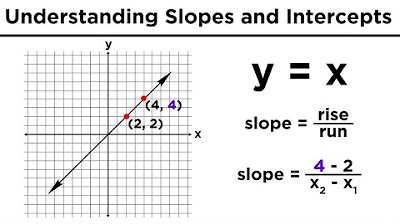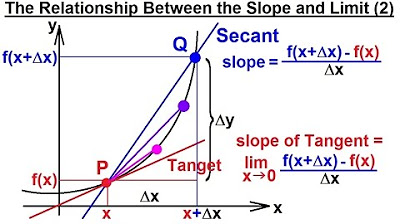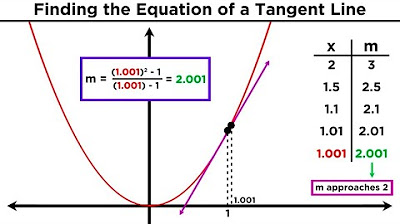Calculus 1 Lecture 0.1: Lines, Angle of Inclination, and the Distance Formula
TLDRIn this engaging lecture, the speaker embarks on a comprehensive review of fundamental mathematical concepts that are crucial for success in calculus. The session begins with an exploration of the properties of lines, delving into the infinite points that define a line and the necessity of at least two points to establish its slope. The concept of slope is unpacked as the rate at which a line rises or falls, leading to an interactive exercise where the class collaboratively derives the formula for slope using two generic points on a line. The lecture progresses to the derivation of the point-slope form of a line's equation from the slope formula, emphasizing the flexibility of using one fixed point and one variable point. With the foundation laid, the speaker transitions into the slope-intercept form, illustrating how to graph lines and the characteristics of horizontal and vertical lines. The discussion further extends to parallel and perpendicular lines, highlighting the significance of slopes in determining their relationship. The lecture concludes with an introduction to angles of inclination, their connection to slope through the tangent function, and a practical application of the distance formula. Throughout the session, the speaker skillfully weaves in humor and encourages class participation, making the complex world of calculus accessible and enjoyable.
Takeaways
- 📚 The class is a review of essential math concepts, including basic algebra, necessary for success in calculus.
- 🔍 Section zero covers fundamental topics such as lines, families of curves, trigonometric functions, and the concept of slope.
- 📈 A line is characterized by having an infinite number of points and a slope that determines its rise or fall.
- 📐 To graph a line, you need at least two points or one point with a known slope; the slope is calculated using the formula (y2 - y1) / (x2 - x1).
- 🧮 The slope formula can be manipulated to derive the point-slope form of a line's equation, which is useful for finding the equation of a line given a point and a slope.
- 🟡 The point-slope form of a line's equation is y - y1 = m(x - x1), where m is the slope and (x1, y1) is a point on the line.
- 🟠 A line with the equation y = mx + b is in slope-intercept form, where m is the slope and b is the y-intercept.
- 🔶 For parallel lines, the key property is that they have the same slope, meaning they will never intersect.
- ⚪ A horizontal line is represented by the equation y = c, where c is a constant, and a vertical line is represented by the equation x = d, where d is a constant.
- 🔄 To convert a line's equation from standard form to slope-intercept form, solve for y by isolating it on one side of the equation.
- 📐 The distance between two points (x1, y1) and (x2, y2) is found using the distance formula: √((x2 - x1)² + (y2 - y1)²).
Q & A
What is the first topic discussed in the calculus class?
-The first topic discussed in the calculus class is basic lines, including the concept of slope and how to graph lines using two points.
How is the slope of a line defined?
-The slope of a line is defined as the rise over the run, which is the change in y (vertical change) divided by the change in x (horizontal change).
What is the point-slope form of a line's equation?
-The point-slope form of a line's equation is given by the formula (y - y1) = m(x - x1), where m is the slope and (x1, y1) is a point on the line.
How can you find the equation of a line from its slope-intercept form?
-You can find the equation of a line from its slope-intercept form (y = mx + b) by knowing the slope (m) and the y-intercept (b), which is the point where the line crosses the y-axis.
What is the relationship between the slope of a line and its angle of inclination?
-The slope of a line is equal to the tangent of its angle of inclination (θ). The angle of inclination is the angle a line makes with the positive direction of the x-axis.
How can you determine if two lines are parallel?
-Two lines are parallel if they have the same slope. Parallel lines never intersect and maintain a constant distance from each other.
What is the condition for two lines to be perpendicular?
-Two lines are perpendicular if the product of their slopes is -1. In other words, if one line has a slope m, the other line has a slope of -1/m.
What is the slope-intercept form of a line?
-The slope-intercept form of a line is written as y = mx + b, where m is the slope and b is the y-intercept, the point where the line crosses the y-axis.
How do you convert a line's equation from standard form to slope-intercept form?
-To convert a line's equation from standard form (Ax + By = C) to slope-intercept form, you need to solve for y. This typically involves isolating y on one side of the equation by subtracting Ax from both sides and then dividing by B.
What is the distance formula and how is it derived?
-The distance formula is derived from the Pythagorean theorem and is used to find the distance between two points (x1, y1) and (x2, y2). It is written as D = √((x2 - x1)² + (y2 - y1)²).
How can you find the slope of a line given its angle of inclination?
-You can find the slope of a line given its angle of inclination by using the formula m = tan(θ), where m is the slope and θ is the angle of inclination in radians.
What is the difference between a horizontal line and a vertical line in terms of their equations?
-A horizontal line has a constant y value and can be represented by the equation y = C, where C is the y-intercept. A vertical line has a constant x value and is represented by the equation x = D, where D is the x-intercept.
Outlines
📐 Introduction to Calculus and Review of Basic Concepts
The video begins with an introduction to calculus and a review of fundamental math concepts essential for success in the course. It covers basic lines, families of curves, trigonometric functions, and the concept of slope. The importance of having at least two points to define a line and the role of slope in determining the incline of a line are discussed. The process of deriving the slope formula using two generic points is demonstrated, emphasizing the need for a general formula applicable to all points on a line.
🔢 Deriving the Equation of a Line from the Slope Formula
The video continues by illustrating how to derive the equation of a line using the slope formula. It explains the concept of fixing one point and allowing the other to vary, which leads to the point-slope form of a line's equation. The process involves manipulating the slope formula to express it in terms of a single variable, which then allows for the creation of a general equation for a line. An example is provided to demonstrate how to apply this knowledge to find the equation of a line passing through two given points.
📈 Finding the Slope and Equation of a Line Given Points
The presenter guides viewers through the process of finding the slope of a line given two points and then using that slope to find the line's equation. The importance of having both a point and a slope to define a line is emphasized. The video shows how to correctly label coordinates and apply the slope formula. It also covers how to manipulate the point-slope form to express the equation of a line in slope-intercept form, making it easier to graph.
🔍 Understanding Horizontal and Vertical Lines
The video touches on the characteristics of horizontal and vertical lines, explaining how the presence of a constant value for y or x in an equation indicates the type of line. It clarifies that a horizontal line has a slope of zero, while a vertical line has an undefined slope. The presenter also discusses converting a line's equation from standard form to slope-intercept form and introduces the cover-up method for graphing lines from standard form.
🤝 Parallel and Perpendicular Lines
The concept of parallel and perpendicular lines is introduced, with a focus on how their slopes relate to each other. It is explained that parallel lines have the same slope, while perpendicular lines have slopes that are negative reciprocals of one another. The video also covers how to find the equations of lines that are parallel or perpendicular to a given line, given a specific point.
🧮 Solving for Parallel and Perpendicular Lines
The presenter provides a practical example of finding the equations of lines that are parallel or perpendicular to a given line, using a specific point. The process involves identifying the slope of the given line and then applying it to the point-slope formula to find the new line's equation. The video also explains how to adjust the slope to find a perpendicular line, emphasizing the relationship between slopes and their reciprocals.
📐 Angle of Inclination and Trigonometry
The video delves into the concept of the angle of inclination, which is the angle a line makes with the x-axis. It connects the angle of inclination with the slope of a line through the tangent function from trigonometry. The relationship between the slope (m) and the tangent of the angle of inclination (θ) is established as m = tan(θ). The video also covers how to find the slope of a line given its angle of inclination and vice versa, using the tangent function and its inverse.
🔢 Finding the Angle of Inclination from a Given Slope
The presenter explains how to find the angle of inclination when given a slope, using the inverse tangent function (tan^-1). It is shown that if the slope (m) is known, one can find the angle (θ) by calculating tan^-1(m). The video highlights the importance of the unit circle in trigonometry for determining the angle when the slope is given. It also touches on the concept of reference angles and how they can be used to find the angle of inclination.
📐 The Distance Formula and Its Relation to the Pythagorean Theorem
The video concludes with an introduction to the distance formula, which is derived using the Pythagorean theorem. The presenter shows how to find the distance between two points in a coordinate plane by considering the differences in their x and y coordinates as the legs of a right triangle. The distance formula is expressed as D = √((x2 - x1)^2 + (y2 - y1)^2), and the video emphasizes the similarity between this formula and the slope formula, noting that the process of applying the distance formula is quite straightforward.
Mindmap
Keywords
💡Calculus
💡Lines
💡Slope
💡Trigonometry
💡Angle of Inclination
💡Slope-Intercept Form
💡Point-Slope Form
💡Distance Formula
💡Parallel Lines
💡Perpendicular Lines
💡Pythagorean Theorem
Highlights
Introduction to calculus with a focus on foundational math concepts.
Review of basic algebra and math concepts necessary for success in calculus.
Discussion on the properties of lines, including infinite points and the need for at least two points to define a line.
Explanation of slope as the measure of a line's rise or fall and how to calculate it.
Derivation of the slope formula from two generic points on a line.
Transformation of the slope formula into the point-slope form of a line's equation.
Illustration of converting the point-slope form into the slope-intercept form for easier graphing.
Method to graph a line using two points and the concept of slope.
Identification of horizontal and vertical lines through the equation's variables and constants.
Technique to convert a standard form line equation into slope-intercept form.
Use of the cover-up method for finding x-intercepts and y-intercepts from a standard form equation.
Parallel lines are defined by having the same slope, while perpendicular lines have slopes that are negative reciprocals of each other.
Process to find the equation of a line that is parallel or perpendicular to a given line passing through a specific point.
Introduction to angles of inclination and their relationship with the slope of a line.
Explanation of how to find the slope of a line given its angle of inclination using trigonometric functions.
Method to find the angle of inclination when given the slope, using the inverse tangent function.
Discussion on the distance formula derived from the Pythagorean theorem, relating to the coordinates of two points.
Emphasis on the importance of understanding algebra and trigonometry for success in calculus.
The class concludes with a review of the key concepts and a confidence check on graphing lines and applying the distance formula.
Transcripts
Browse More Related Video

Graphing Lines in Algebra: Understanding Slopes and Y-Intercepts

Linear Functions

Calculus 1: Limits & Derivatives (4 of 27) The Relationship Between the Slope and the Limit (2)

Understanding Differentiation Part 1: The Slope of a Tangent Line

Ch. 13.3 Tangent Lines and Derivatives

Math 11 - Sections 1.3-1.4
5.0 / 5 (0 votes)
Thanks for rating: